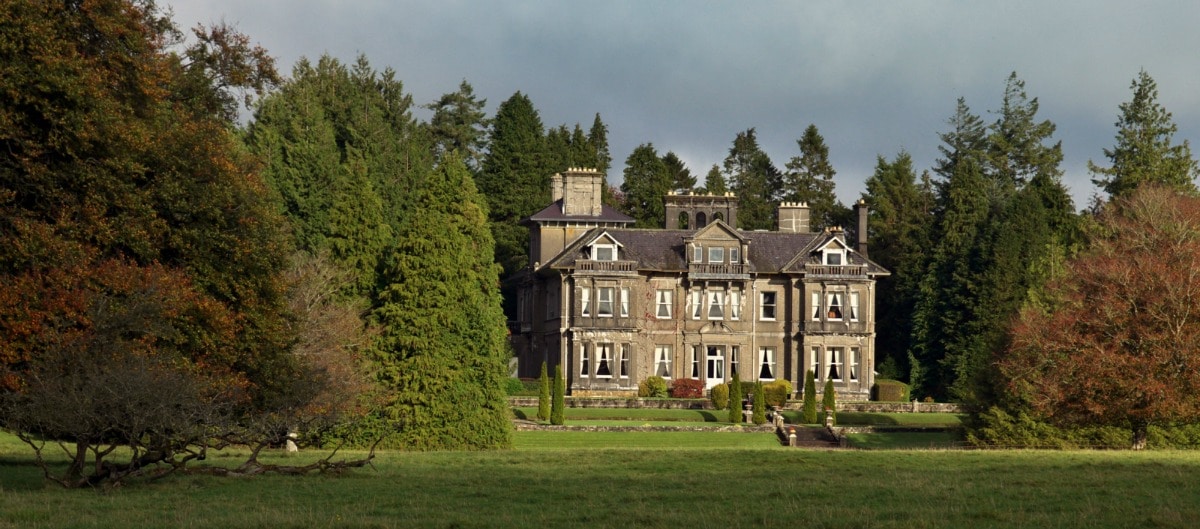Driving Ireland’s snaking country roads is both a challenge and a thrill. You just never know what you’ll uncover. We had already traversed hundreds of miles and crossed several counties; the awe inspiring 7 estates we toured only fueled the fire to discover more of Ireland’s storied past. We were only half way there and already we were looking back with sadness. But our adventure continued.
Kilronan Castle
We left Lough Erne, a golfer’s paradise in Enniskillen, Northern, Ireland, for a leisurely drive to visit Marguerite and Piers O Conor Nash. Their historic estate Clonalis House is in Castlerea which was about two hours away in Western Ireland. Half way to our destination we stopped in the lush countryside for lunch at Kilronan Castle, a massive estate built in 1820 and overlooking Lough Meelagh. The lake views are the draw in the dining room here, so make sure to get a table by the window. The food is good; we enjoyed the duck and the cod, and prices were reasonable. You can walk off your lunch exploring the grounds, forty acres of green pastures and forests.
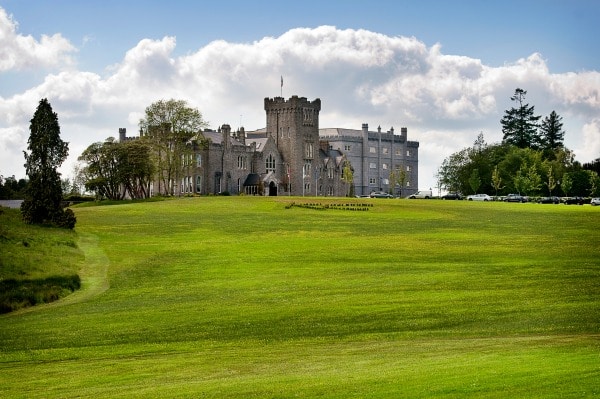
Photo Courtesy of Kilronan Castle
Strokestown Park
An hour later we arrived at Strokestown Park, a manor house built in the 17th century as the family home of the Cromwellian “adventurer” family, the Pakenham Mahons, who resided there from the 1600s until 1979. This grand estate was infamous for its role in the great Irish famine of the 1840s, when thousands of tenant farmers were evicted and forced to emigrate to North America. Today it houses the National Irish Famine Museum. While waiting for a guided tour to begin, we popped into the walled “pleasure garden,” and wandering through this six-acre English-style garden turned out to be a real joy. There were avenues of green arches, a mini maze leading to a green square with large topiaries, a lily pond and several architectural follies. While the house contains plenty of antique furniture, silver and paintings, the interiors were somewhat faded and in need of some “TLC”. Recently the property was taken over by the Irish Heritage Trust and there are high hopes that it will be refurbished and restored to its former glory.
Living History at Clonalis House
It was early evening when we finally arrived at Clonalis House, the ancestral home of the O’Conor family, its iron gates bearing a coat of arms with a tasteful touch of gold. We drove up the long drive flanked by magnificent trees, past picturesque green fields where a herd of cows was languidly grazing.
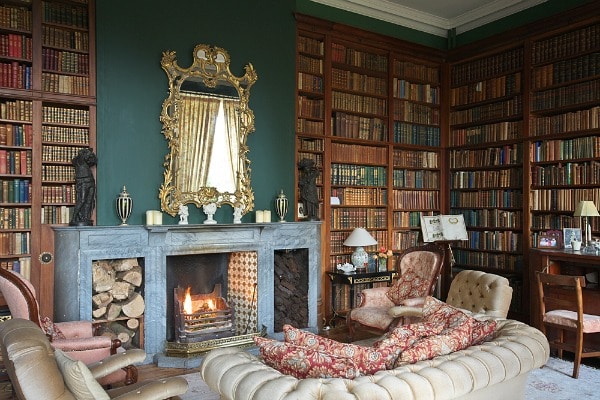
Photo Courtesy of Clonalis House
Marguerite O’Conor Nash
When the house finally came into view we were surprised at how grand the Victorian Italianate-style pile was. We rang the bell, and after a few minutes, an elegant woman wearing an apron appeared. It turned out to be the lady of the house, Marguerite O’Conor Nash, who was the most gracious hostess we’d met in Ireland. We were immediately made to feel at home in this imposing house which sits on land the O’Conors have owned for over 1,000 years. This is unique, the same family living in their ancestral home for ten centuries. The O’Conor family included eleven High Kings of Ireland and 24 Kings of Connacht.
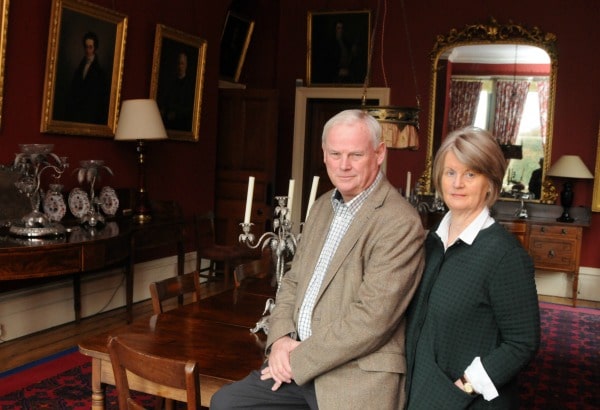
Photo Courtesy of Clonalis House
Pyers O’Conor Nash
The current house was built in 1880 by the great grandfather of today’s proprietor, Pyers O’Conor Nash, a banker who, if history had veered toward the monarchy, would have a claim as High King of Ireland. He is the embodiment of the charming, approachable Irishman, a man of letters and history who drives a tractor like a Ferrari.
In front of the house sits the coronation stone of the Irish kings, one of only two left in the country, used as part of the coronation ritual. On the grounds is a courtyard with a mews and cottages that can be rented; on a walk around the estate you’ll find ruins of the original Clonalis House. Five miles away there are ruins of the O’Conor Castle, called Ballintubber, currently the site of an architectural dig. They’ve gotten down to the 14th Century and have uncovered the foundations of a medieval town.
Intimate Hospitality
A stay at Clonalis House is a deeply personal hospitality experience, as there are only four guest rooms and the family only has eight guests at a time. It’s akin to staying at a great country house, exactly as it would have been in the 1800s. Of course, there aren’t as many scullery maids nowadays, but there is more than sufficient staff to keep the place in impeccable order.
The mansion has 45 rooms furnished with Louis XV and Sheraton antiques, and filled with family heirlooms and costumes. Nine generations of family portraits line the walls, each with an intriguing story.
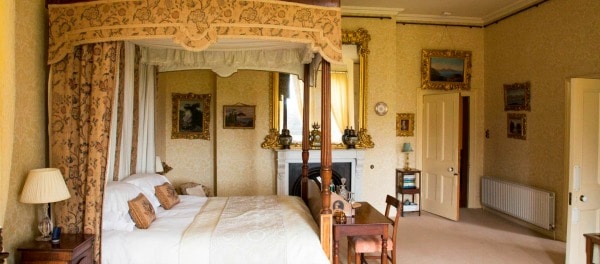
Photo Courtesy of Clonalis House
Stately Rooms
The main floor is a series of elegant and stately rooms all of which are in constant use by the guests. A formal sitting room contains portraits of the beautiful O’Connor ladies; a red-hued dining room has an astonishing assortment of silver table ornaments.
We were ushered to a second-floor corner room complete with four-poster bed and bucolic views, rivaling anything we’d seen on Downton Abbey. The bathroom was as large as many studio apartments in New York City, and came with a sitting area.
We had a lovely dinner in the library, and on another night all the guests dined together in the main dining room as one big dinner party. Breakfast is served in the less formal Kitchen Room and features local breads, eggs, herbs and even plums from Marguerite’s garden.
Hidden Ireland
Clonalis House is part of Hidden Ireland, a grand collection of historic country houses where visitors can stay. These houses are privately owned and very different from other more contemporary accommodations in Ireland. They range from Ireland and Northern Ireland’s most important Georgian buildings to charming rural rectories. What they all have in common is a commitment to traditional hospitality and service.
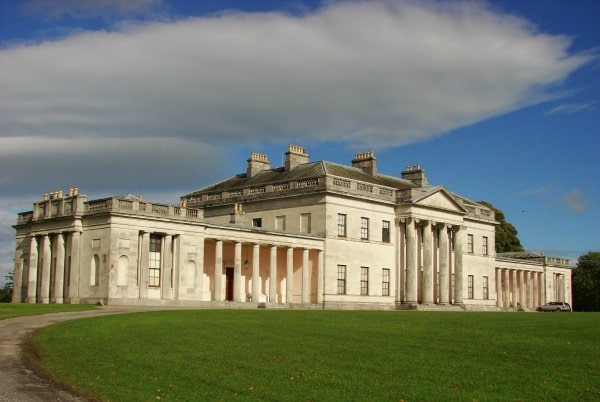
Photo Courtesy of Castle Coole
Castle Coole
The next day we headed to Castle Coole, possibly the grandest Georgian mansion in Ireland and less than two hours from Clonalis House. The interior is incredibly rich and elaborate, and although the castle is run by the National Trust, the contents are still owned by the 8th Earl of Belmore, John Lowry-Corry, who lives in the west wing. He is constantly updating and rearranging the collection of furniture, paintings and objects d’art, so the house is a living exhibition. Queen Elizabeth visited in the late 1980s after a renovation, and Jessica Chastain and Colin Farrell filmed Miss Julie here. Castle Coole’s vast grounds make for lovely long walks year-round, but note that the mansion is only open at certain times of the year.
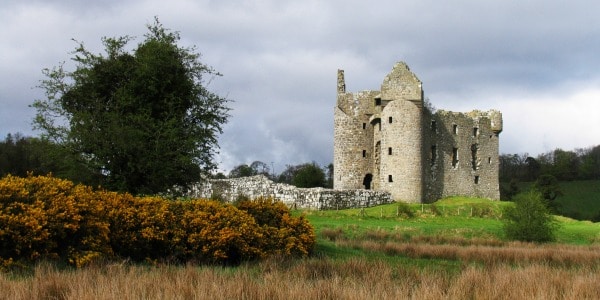
Photo Courtesy of Monea Castle
Monea Castle & Tully Castle
Two more historic locales were on our list – Monea Castle and Tully Castle, both ruins today. At Monea, we came upon herds of cows and their calves and some horses and their young. They happily trotted over to the fence looking for apples; we’d brought some along so we were very popular during our brief visit.
Tully Castle nearby has a tragic, blood-soaked history as the site of a massacre on Christmas Day, 1641, during the Irish Rebellion, a conflict between Irish Catholics and English and Scottish Protestant settlers. The Maguire family attempted to reclaim the property and on Christmas Day killed 60 women and children and fifteen men at the castle, then burnt it to the ground. A visitor’s center in a restored farmhouse at the site features an exhibition of local lore relating to it.
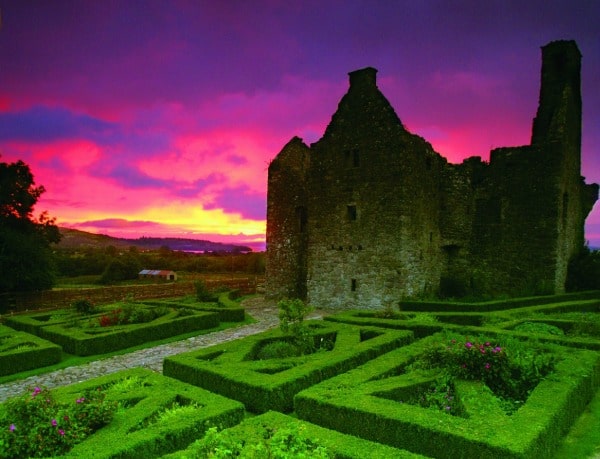
Photo Courtesy of Tully Castle
Ashford Castle
An hour by car from Clonalis House is Ashford Castle, a medieval estate dating from 1228 in a dramatic setting overlooking Lough Corrib. This 5-star luxury hotel is the perfect place for lunch and a stroll around the gardens. Or go all out and treat yourself to high tea which is served in a Victorian-era drawing room with views to the water. The history here is long. In more “modern” times (1852), Sir Benjamin Lee Guinness, a member of the brewing dynasty and the richest man in Ireland, bought the estate. He expanded the place, adding extensions to the house and buying more land. The Guinness family gave the property to the Irish government in 1939 and in 1951, John Wayne and Maureen O’Hara stayed there while shooting the classic movie The Quiet Man. A later renovation turned it into the swank hotel it is today.
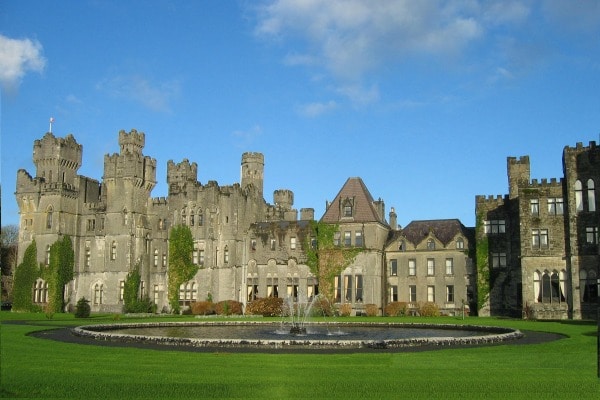
Photo Courtesy of Ashford Castle
On the flight home, thinking back on our romantic and certainly epic road trip, I realized that a part of me had been left behind in Ireland. It’s a place that can easily do that to anyone who visits. My advice is to get out of the cities and explore the country’s fascinating heritage and don’t let the left-hand side of the road driving stop you!
[alert type=white]
The country code is 353 for the Republic of Ireland and 44 for Northern Ireland.
The Castles & Country Houses:
Kilronan Castle Estate & Spa, Ballyfamon, Boyle, Co. Roscommon, F52 R867, Republic of Ireland, Phone: (0) 71 9618000, www.kilronancastle.ie
Strokestown Park, The Irish National Famine Museum, Strokestown, Co. Roscommon, Republic of Ireland, Phone: (0) 71 9633013, www.strokestownpark.ie
Clonalis House, Castlerea, Co. Roscommon, Republic of Ireland, Phone: (0) 94 9620014, www.clonalis.com
Hidden Ireland, P O Box 31, Westport, Co. Mayo, Republic of Ireland, Phone: (0) 98 66650, www.hiddenireland.com
Castle Coole, Belfast-Enniskillen road (A4), Enniskillen, Co. Fermanagh, BT746JY, Northern Ireland, Phone: 28 6632 2690, www.nationaltrust.org.uk/castle-coole
Ashford Castle, Cong, County Mayo, Republic of Ireland F31 CA48, Phone: 94 954 6003 www.ashfordcastle.com
[/alert]

